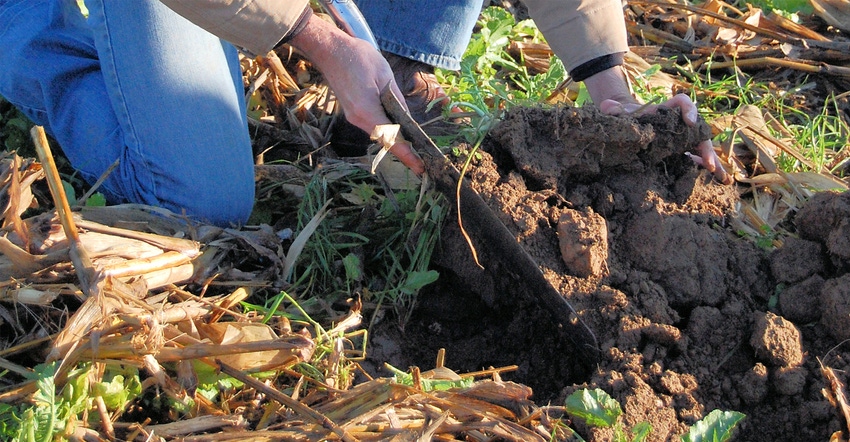
During New York Farm Show, several farmers brought up the subject of soil health — a healthy sign that old attitudes are changing. One shared that his brother had picked up a rental farm “manured” for many years. The previous tenant stopped the practice and continued plowing. Yields steadily declined to the point that his brother became the new tenant.
So why is tillage so ingrained into our agrarian society? Doug Peterson, regional soil health specialist for USDA’s Natural Resources Conservation Service, says the ritual was inherited. It was the old way of creating a desirable seed bed.
What our ancestors didn’t realize, he adds, is that tilling causes soil to lose aggregate stability. When one piece of soil breaks loose from another, erosion occurs. That’s why tilled fields experience sediment and nutrient loss — and why granddad’s soil is long gone.
Even without thinking about erosion, Peterson says, “you need to realize what soil aggregate stability [enhanced by root exudates that glue soil particles together] is going to do for water infiltration. When we get a rainfall, 50% to 80% of that water will run off in a tilled field. Aggregate stability is something we totally missed for a long time in the soil conservation world.”
Plant this corn silage plan
With feed costs being close to 60% of a dairy operation’s budget, you have a lot riding on having plentiful stocks of high-quality feed. Corn silage is the biggest ration component, and newer silage hybrids often have significantly improved nutritional traits you can bank on, according to Jon Erickson, Mycogen Seeds’ commercial agronomist.
Dig into commercial and university research trial data. Tonnage isn’t the only corn-picking point. That’s why trials by Cornell University, Penn State University and University of Vermont are incorporating feed values expressed in milk equivalents. Those values may encourage you to adjust acreages committed to specific hybrids. Check them out by reading 6 corn-picking pointers for 2018.
Also, consult with agronomists to determine where to plant those hybrids and at what populations. Erickson notes that for highly digestible silage hybrids, a plant population between 32,000 and 34,000 seeds per acre is generally a good fit.
Source: Mycogen Seeds
Today’s nitrogen no longer just N
Growers successful in moving up average corn yields are employing treated nitrogen to prevent the great N escape — ammonia volatilization, nitrate leaching denitrification and N gas loss from soil, points out Grant Troop, certified crop consultant for AgXplore. Today’s N may be encapsulated with delayed-release materials, micronutrients and even biologicals. Sure, they cost more than plain old N, but the benefits can far outweigh the costs.
Troop cited Drew Haines of Middletown, Md., as an example. Haines’ 2017 National Corn Yield Contest entry placed second in Division A Class A non-irrigated category at 341.6 bushels, topping the Maryland competition.
Haines saw a crop response to a foliar application of NutriPak (a proprietary blend of encapsulated urea and ammonium phosphate) plus a blend of boron, copper and zinc at V3 to V5 stages. His goal was to maximize kernel rows and increase row length. Note: This was only part of his N management strategy.
The lesson here: If you haven’t updated your nitrogen management strategies for a while, then it’s time to reassess application guidelines — including timing — for agronomic and economic efficiency.
Source: AgXplore
So what about sulfur?
Unless your soil or tissue testing results show sufficient sulfur, more and more Northeast farmers are achieving beneficial results with S. That’s particularly true with accelerated crop removal via silage harvest. It’s not just a corn problem.
Dry products like ammonium sulfate, with an analysis of 21-0-0-24S and K-Mag at 0-0-22-10Mg-26S, are good sources for spring use according to Jeff Nagel, agronomist for Ceres Solutions Cooperative. Gypsum is another S source. But don’t count on elemental S for early-season needs, he says.
Ammonium thiosulfate, or 12-0-0-26S, is a liquid S that can be applied at planting in a 2-by-2-inch starter, broadcasted with UAN or sidedressed with UAN. Blended with a nitrogen source, the cost is equivalent to about 2 bushels an acre, Nagel says.
Grow more corn root hairs
Yes, you can give corn root hairs a health boost, thanks to a variety of in-furrow-applied microbiological products. Some may work better than others, so do some careful researching and field trials to make sure they yield more than they cost in your soils.
MycoApply EndoPrime, touted by Valent, employs four mycorrhizal fungi species to help improve nutrient efficiency, drought tolerance and yield potential. How, you wonder? They colonize on root hairs and create hyphae filaments that further extend into the soil, explains Todd Mayhew, Valent product development manager. The hyphae also produce enzymes that release nutrients tied up in the soil and create vesicles to store resources until needed by the plant.
In upper Midwest grower trials in 2017, 57% of growers saw fuller root masses compared to untreated corn. That spells an advantage under drought stress conditions. Valent’s formulation is easier to pre-slurry than its pre-launch formulation, Mayhew says.
Source: Valent
Index soil insects
Index, from Amvac, is a new two-mode insecticide for corn that controls western and northern corn rootworms, wireworms, cutworms, grubs and other soil insects. This restricted-use liquid organophosphate insecticide is applied in-furrow at planting for corn, sweet corn and popcorn. Chlorethoxyfos and bifenthrin are the active ingredients.
Source: Amvac
About the Author(s)
You May Also Like




